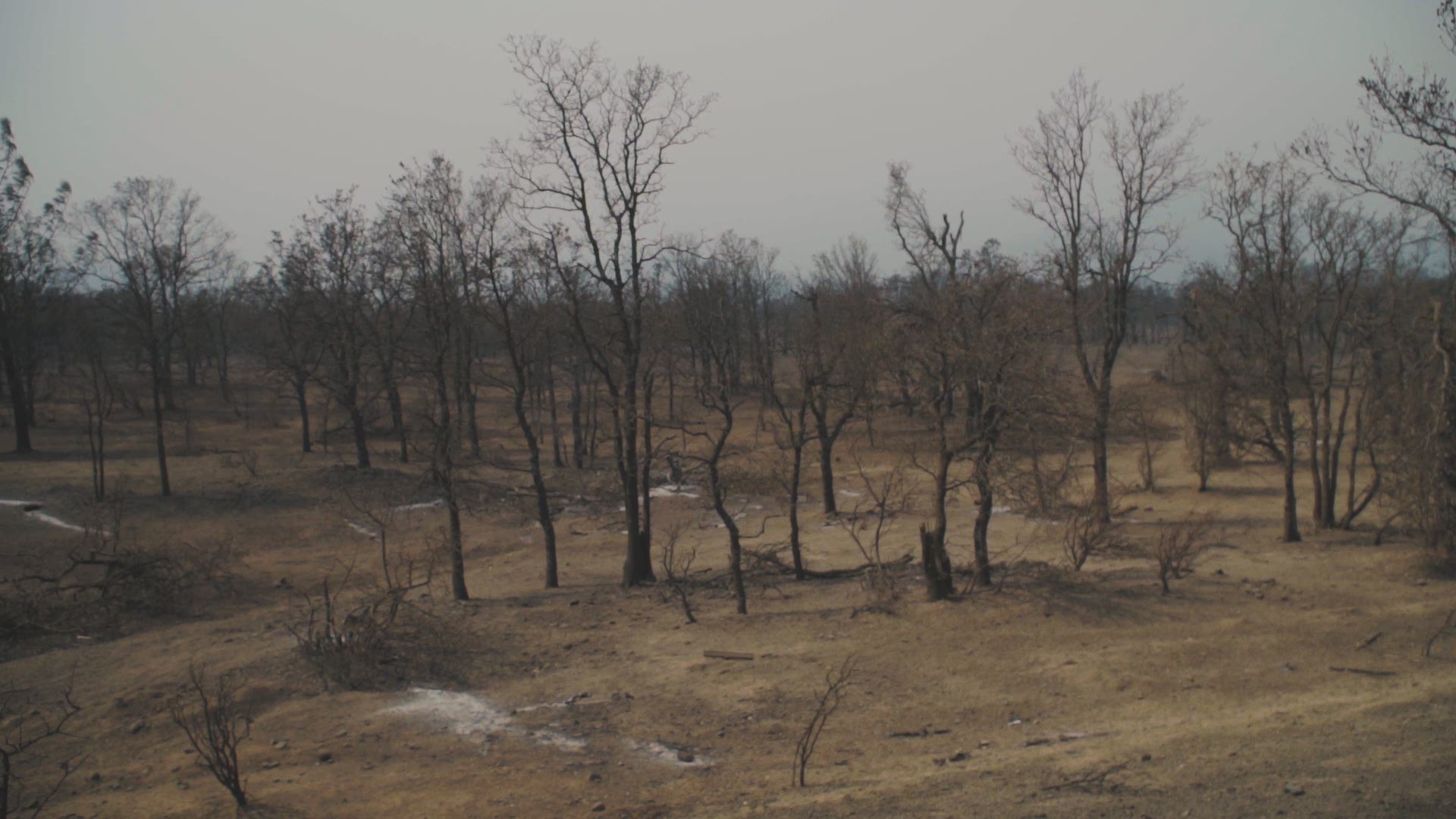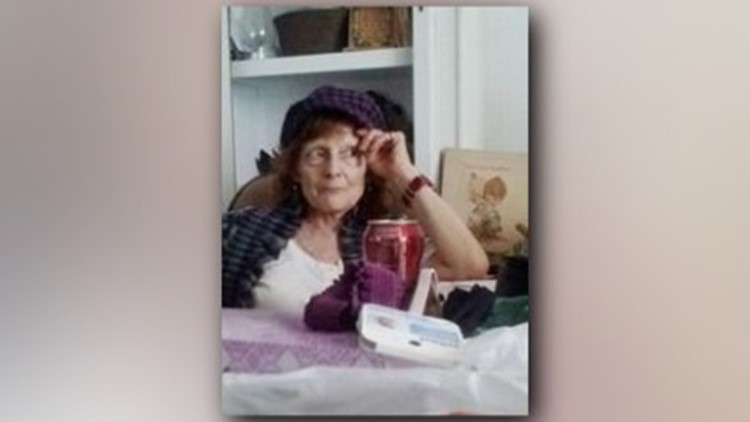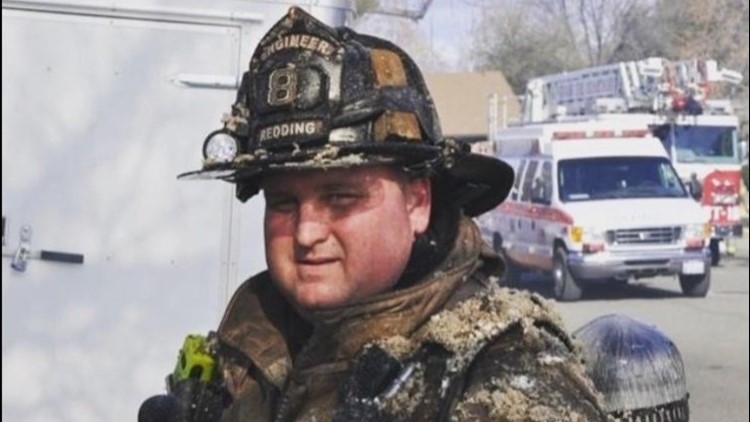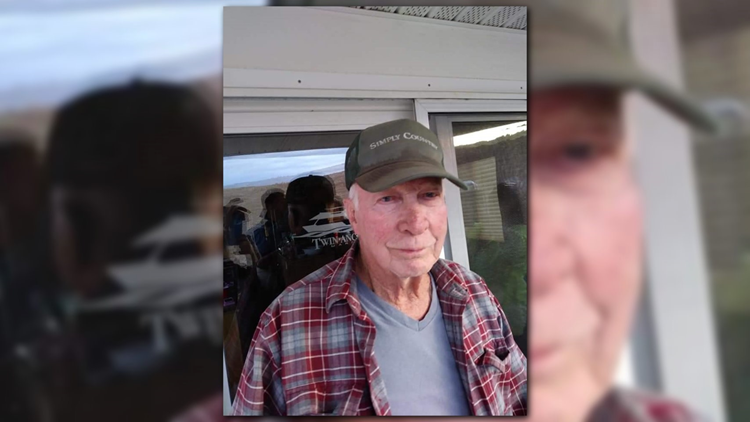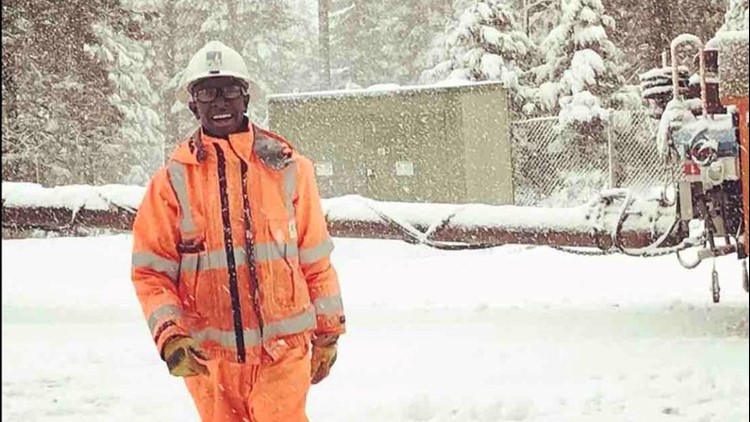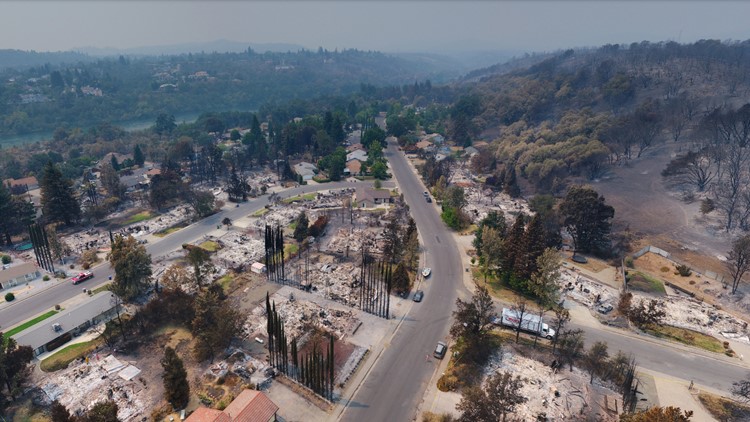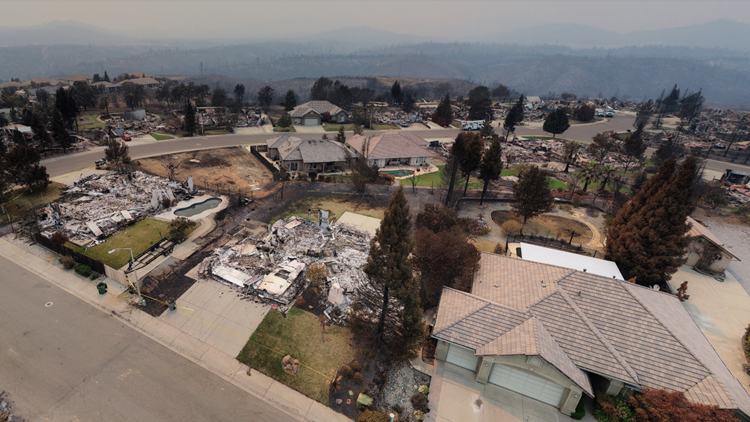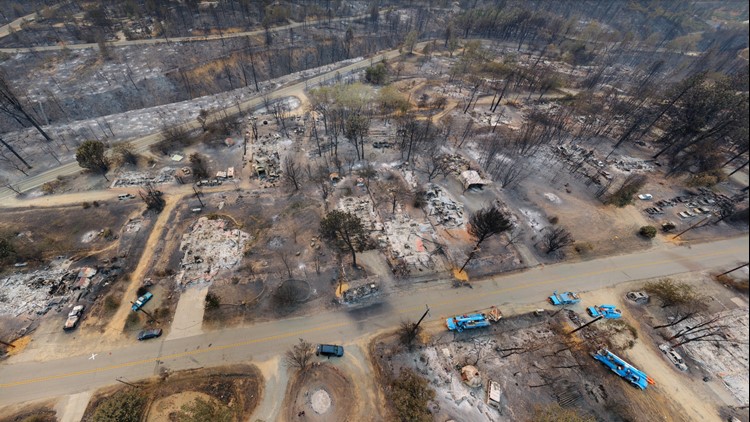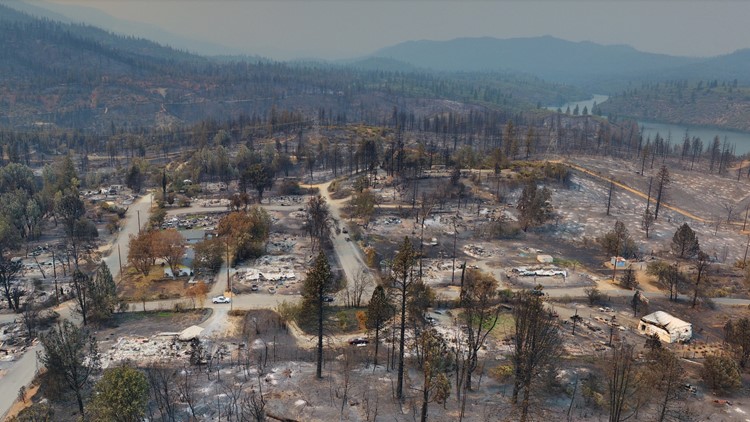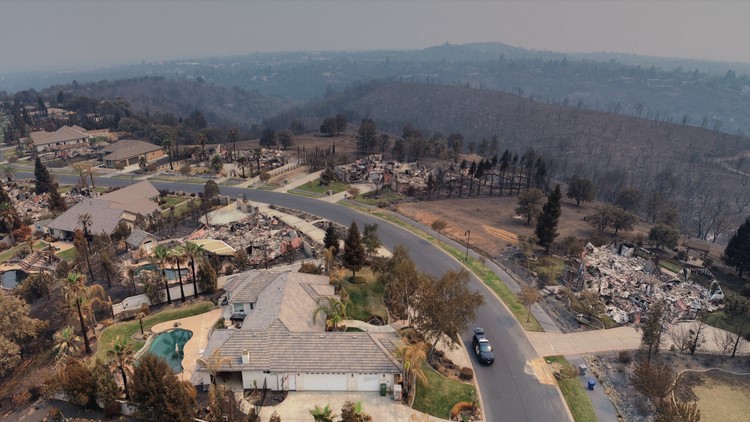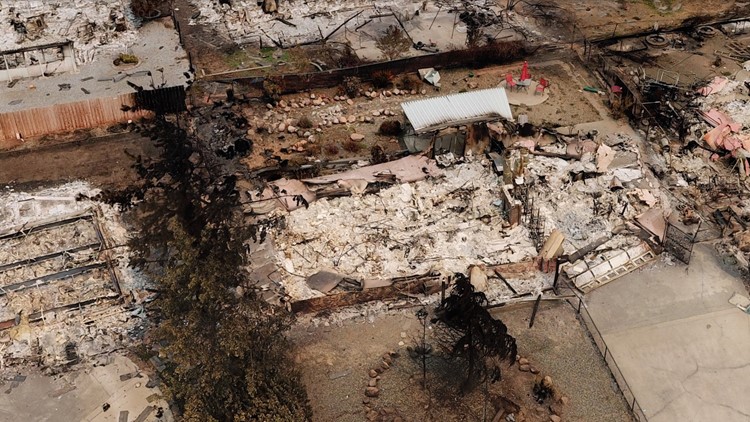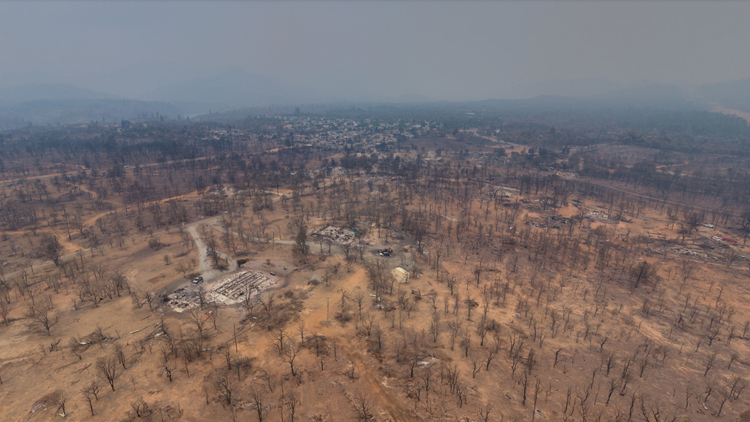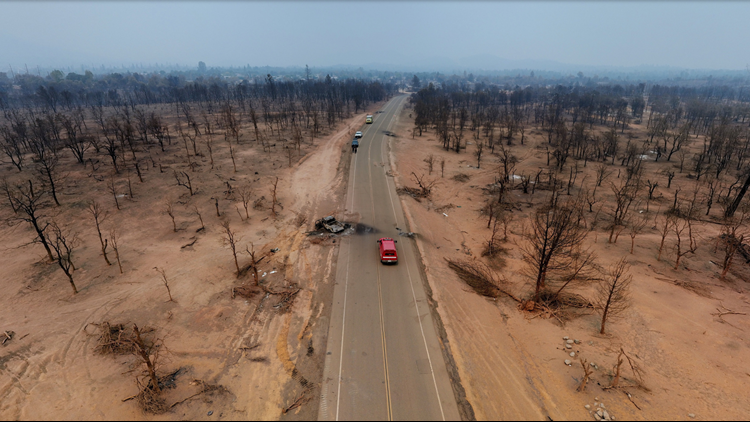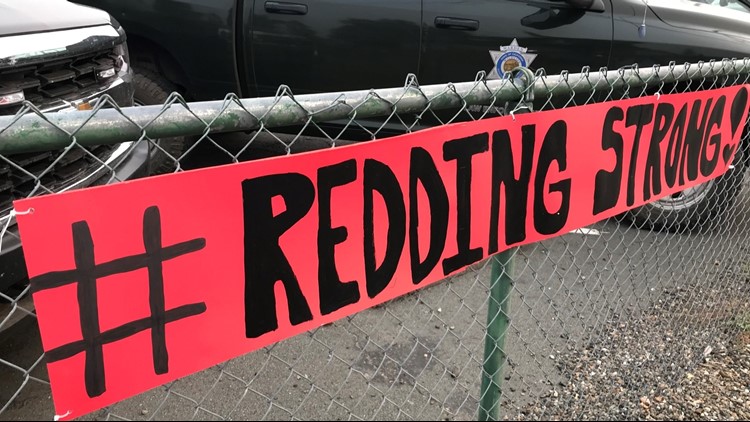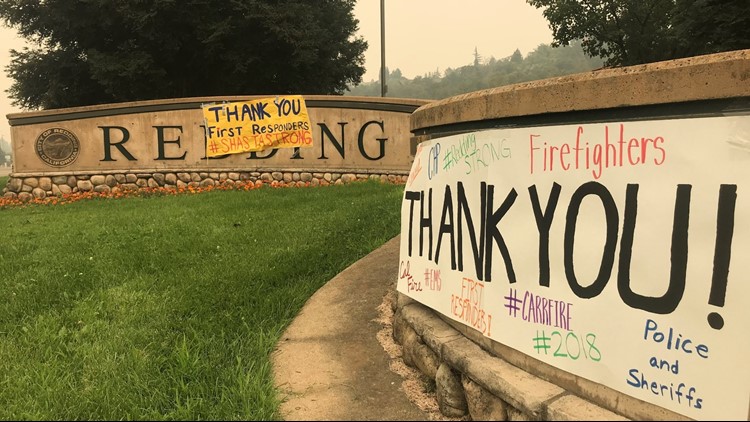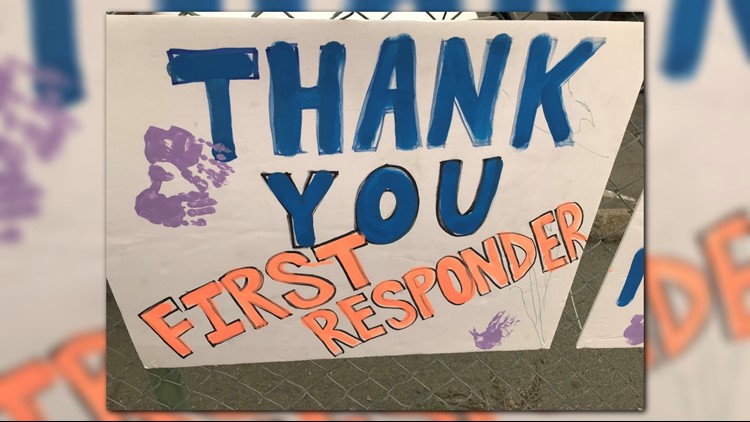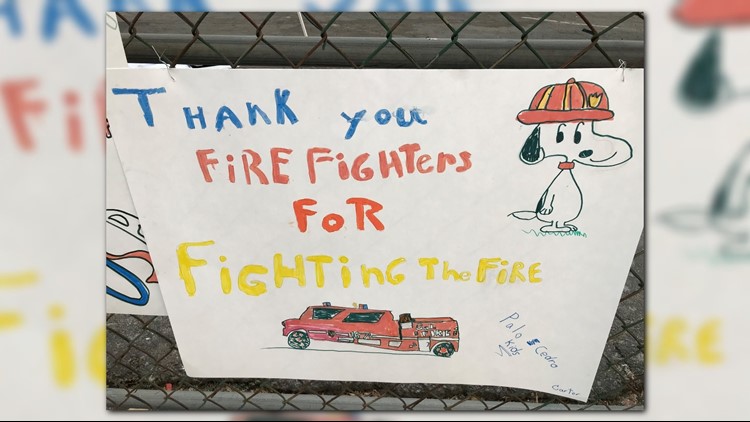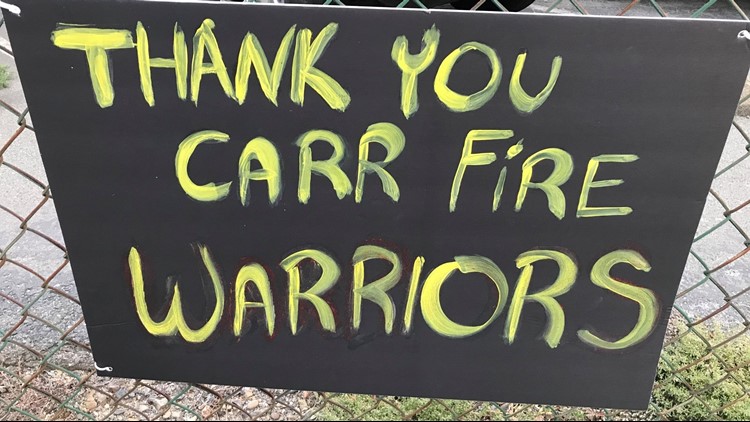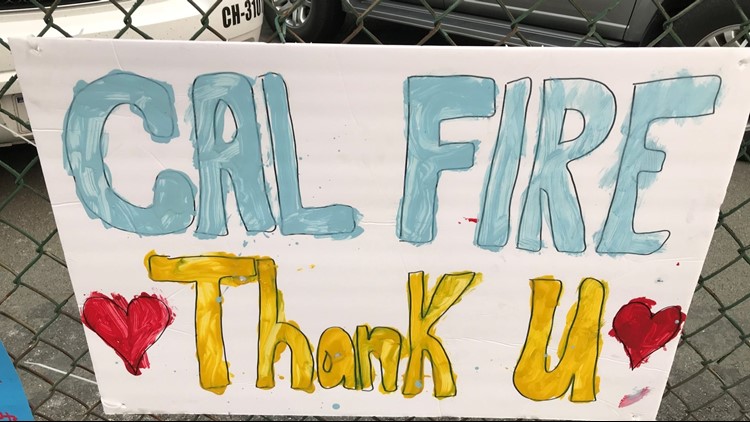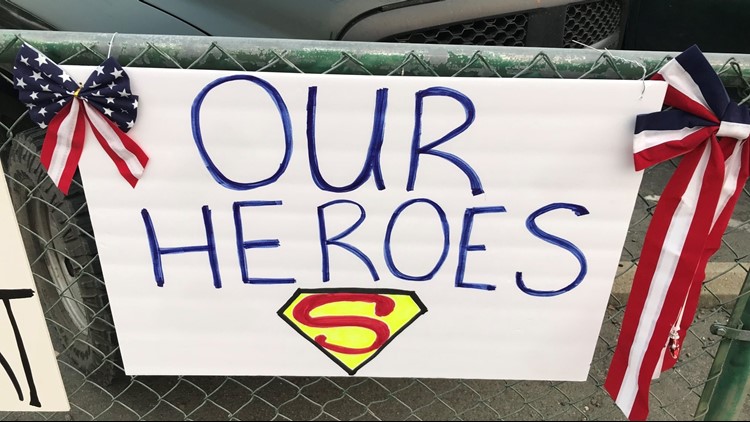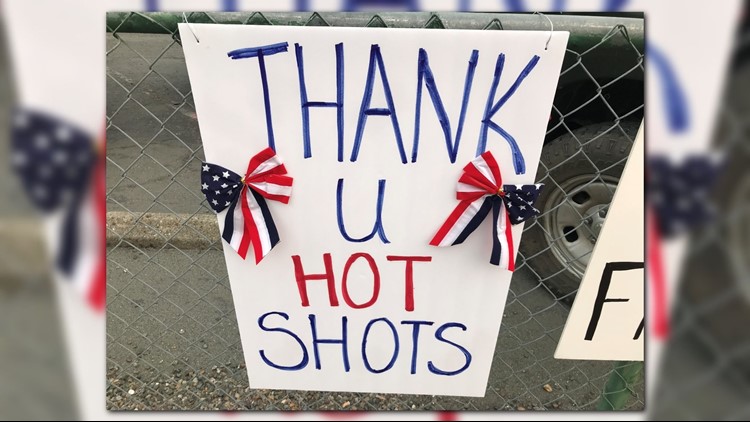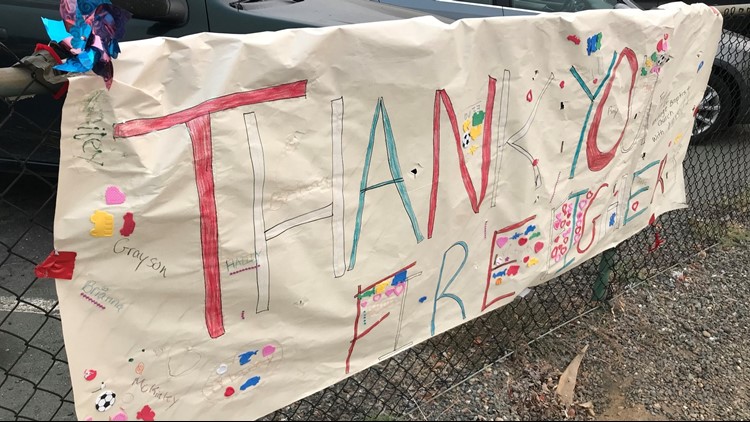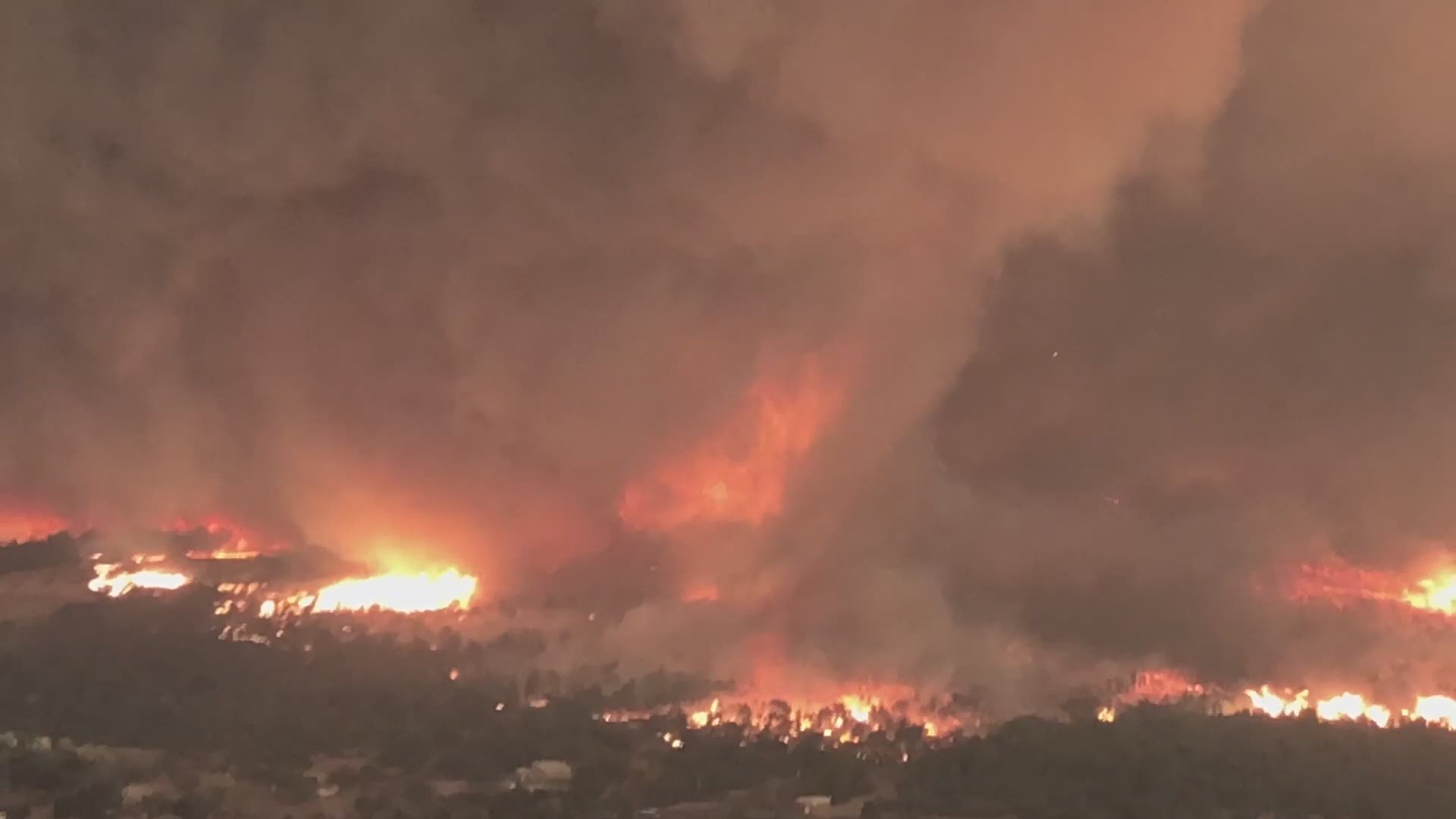If you're viewing on the ABC10 App, tap here for multimedia.
A panel of Redding firefighters recalled first-hand Saturday how they fought the Carr Fire as best they could and apologized for not being able to save more homes from the unrelenting inferno.
Two months removed from the start of what became the sixth most destructive fire in state history — and the worst-ever natural disaster in Shasta County — Redding Professional Firefighters Local 1934 hosted what it called a community debriefing at the United Public Employees of California building off Park Marina Drive.
The five firefighters shared their experiences the evening of July 26 when the encroaching blaze destroyed 261 homes in west Redding subdivisions. They also answered questions from residents, some of whom told their own stories of harrowing escapes and losses they experienced.
The two-hour meeting answered questions such as why it's never a good idea to save yourself from a raging fire by jumping into a swimming pool and that homeowners should seriously think twice before installing landscaping bark. One man said he was going to "grow rocks" instead.
The group also heard one woman's inspiring story of a firefighter saving her home's U.S. flag as flames were at his feet and what firefighters were surprised to find on the ground in the Buenaventura Boulevard area where Redding firefighter Jeremy Stoke lost his life.
The nearly 230,000-acre Carr Fire blamed for eight deaths "was not your ordinary wildland fire," firefighter Joe Hansen said.
"This was a conflagration of structure fires. The fuel load wasn't just brush and trees and grass. It was also homes and vehicles and people's belongings," he said.
That Thursday in July "was probably the worst day, night, month or even longer for a lot of us ... and we're all hurting," Hansen said. "All of us (on the panel) were on the streets that night."
"We saw and did things that we never dreamed we'd be doing in our hometown," Hansen said. "Our city's been knocked down but our community, unbelievably, is stronger than ever."
Hansen pointed to charitable efforts in the community to help victims. Still, the fire department wished it could've done more.
"We're so sorry for your loss and for those of you who have lost houses and have friends who have lost houses. It's so tough for us because our job is to save houses. We're really sorry about that," panelist and firefighter Brett Morris told the audience.
Morris said support from the community "has been really awesome" in the form of thank-you signs and people dropping into stations to say hello.
PHOTOS: Victims of devastating California wildfires
Pool 'isn't going to work'
Bill Berry said he and his wife live in the forest with a pool off Ledgewood Drive west of Grant School and were watching TV that Thursday when he walked outside a little after 5:30 p.m.
"I saw a cloud of smoke where the real action was in town, I guess, that was so scary it looked like a hydrogen bomb to me and I said, 'We're getting out of here as quick as we can.'"
Berry and his wife spent minutes removing gas cans from their garage, moving their grill from under the eaves to inside their home and parked a car by the grass near their pool before evacuating.
"Had I had the courage to stay, what the hell would I have seen?" he asked the firefighters.
When he returned home, he said it looked like the fire split into two paths around the pool.
"It torched this side and torched that side, but my house is OK," Berry said. "I look around at some of my neighbors and they don't have a house. They have rubble now."
Berry said he walked through ashes to check on the home of a neighbor he never had the chance to meet. "I hiked the side of the mountain over to his house. It's not there."
He had half a thought of sending his wife away from their hillside property and riding out the fire in their pool if he needed to.
Hansen's advice: "Your swimming pool isn't going to work. Just get out of the way."
"I can't overemphasize enough the decision you made to leave was the correct decision," he said.
Another panelist, Capt. Ryan Nardo, said people have survived vegetation fires that way but added: "It's important to realize that's a dangerous place to put yourself. It kind of burdens us with a different task."
Had Berry stayed, fire crews would have needed to switch to lifesaving duty for the 80-year-old instead of trying to save nearby homes.
Photos: Drones show Carr Fire destruction from above
Thumbs down on bark
Rich Bullock, whose home was damaged at the bottom of Spinnaker Drive near Quartz Hill Road, said he wouldn't have wanted to be in his pool when the fire came through.
When he returned home, he found landscaping bark floating in the pool among burned cinders, and the foul water had to be drained.
Bullock had bark nearly surrounding his house. "All of it burned," he said.
"If we had not had bark up against almost every side, we probably would've had very little damage," he said. "As it is, we're approaching $50,000, $60,000, $70,000 worth of damage just because of the bark that burned."
Royal Burnett, who's retired from the fire service, said a bark fire is usually just going to smolder until it's put out with a water hose.
However, he said, "When you get a bark fire and 100-mph winds, you're dealing with flames 2 to 3 feet high."
He suggested homes have metal flashing installed as a flame-proof barrier at ground level so burning bark doesn't have a path to the foot of a home's foundation.
"If you have a fire-resistant house and you put the fuel loading there, shame on you," Burnett said.
He said homeowners should have nothing flammable within 5 feet of their homes, including ornamental plants. One woman said she learned not to have rosemary bushes next to the house because of oil in the plant. "Just go buy it at the store."
Burnett said he and some retired fire service buddies went to burned neighborhoods to study why so many homes were lost. For instance, he doesn't recommend dog-eared cedar and redwood fences, nor palm trees.
"The fences were like fuses that went from one yard to the next yard to the next yard and then burned a house two blocks in."
"The palm trees became almost like pillars of fire. They're the most flammable tree you can imagine," Burnett said.
Hansen is one of three Redding firefighters who lost their homes in the blaze and his house on Kellinger Street in Land Park had bark in the yard.
"I'm never going to put landscaping bark anywhere," he said.
The wind from the Carr Fire was so fierce that Hansen thinks bark from the Land Park subdivision was blown several miles to the east and could've landed in Bullock's pool on Spinnaker Drive and the bark there could've been flung south another couple of miles to Lake Redding Estates.
After the fire went through, firefighters were surprised to find wind-blown mail from about four miles away, near Stoke's accident site on Buenaventura Boulevard.
"We were finding pieces of mail by the accident site that was from Old Shasta. How it didn't burn, I don't know," Hansen said.
PHOTOS: Firefighters, thank you
Path of fire tornado activity
Bullock said he had an eight- to 10-minute warning to evacuate before the fire destroyed about 25 homes on his block in Spinnaker Drive.
"The police chief lived right up the street and he came down yelling at everybody to get out now. We didn't even realize the fire tornadoes were behind us, coming up," he said.
Police Chief Roger Moore lost his home in the blaze that firefighters said advanced seven miles over one-and-a-half hours.
"It's a miracle that we didn't lose people in there," Bullock said.
He asked the firefighters whether there was more than one fire tornado.
"We were watching for the fire to come from Keswick, which was to our west, and it seems like (the fire tornado) came across the river from the south," he said. "It looked like one (fire tornado) came through the open space to the east between Spinnaker and White Sail drives."
Hansen said the fire tornado that went across Buenaventura Boulevard where Stoke lost his life "absolutely did make its way all the way to Spinnaker Drive and the whole Quartz Hill area and the River Ridge neighborhood."
July 26 tied a record that day for 113 degrees heat while the North Coast was a cool 54 degrees. The massive heat gradient created a "superwind" blowing 20 to 22 mph from Whiskeytown into Redding that led to the extreme fire behavior, Hansen said.
"Wind coupled with heat, coupled with some pretty extreme topography ... (the fire tornado) did jump the river just downstream from Keswick," he said. "That's when it made its run up the south-facing slope with the river canyon right below Land Park and Stanford Hills."
That's also when a massive fire plume that had begun rotating earlier in the day "really picked up steam" behind the Land Park neighborhood, Hansen said. The fire tornado went across Buenaventura through the open space and split, or collapsed and split, to reach the Lake Redding area and arrive at Spinnaker.
Hansen called the tornado "an absolutely unprecedented event" although fire experts have video evidence of a similar "firenado" occurring in 2014 during the 32,400-acre Eiler Fire near Hat Creek in eastern Shasta County.
"But we've never had one that's created such devastation and had such force to rip apart kV lines, towers, to throw Conex boxes a half-mile, flip cars over, rip trees out of the ground," Hansen said.
Matt Oliphant, another firefighter panelist, said he didn't think the flames were going to jump the river. "The Sacramento River is a pretty big fire break," he said.
Three Redding engines were assigned to the east side of the river to watch for flying embers that day.
But Oliphant said he experienced the fire's ferocity that night in Land Park. The wind was so strong that he needed both hands to try to shut a door on Engine 8. He said the wind ripped the door out of his hands and off the engine.
"One of the seats of Engine 8 got burnt, there were so many embers blowing through the air," he said.
Firefighter staffing
Audience questions also turned to how many Redding firefighters were on duty that Thursday.
Oliphant said about two-thirds of the department's 66 firefighters were working, including some who came in from vacation and canceled time off. Usually 22 to 23 city firefighters are at work daily.
Still, Oliphant said, "We definitely did not have enough firefighters that night."
After the Carr Fire started July 23 at Whiskeytown, crews were used in that area from the California Department of Forestry and Fire Protection, the National Park Service and the U.S. Forest Service along with some Redding firefighters.
Fire crews also arrived from Sacramento, the Bay Area, Fresno, San Diego, Los Angeles and states including Oregon.
"All of the agencies were behind the 8-ball from the beginning. We did the best we could with what we had," said Mike Henry, another firefighter panelist. "We staffed every apparatus that we could."
"For that initial burst of five, six days, every single person we had that wasn't on injury that was able to be there, was there for you guys," Henry told the audience.
Redding staffs most engines with two firefighters and some with three-person crews. They'll send a four-person company on engines out of town for mutual-aid assignments because that's what other agencies do in return.
Morris said they were lucky the department was "upstaffed" that day but the panel said having a higher manpower level would've helped.
"We ultimately needed more people and more people on the engines and maybe we could've made more of a difference," Hansen said.
The National Fire Protection Association recommends fire engines be staffed with a minimum of four firefighters for safety reasons.
Hansen said the department was so strapped that night that crews were able to make some saves on some homes, but it got to the point where firefighters were triaging houses — protecting homes that weren't already engulfed.
That helps explain random patterns of what homes firefighters were able to save.
"I know from experience that night a lot of those two-person companies were fighting fires as best they could and then with only two guys, it pretty quickly turned into fighting for your life, not so much fighting fire," Hansen said.
"It's a frustration of all of ours but that doesn't mean we're not going to stop trying," he said.
Giving thanks
A Muletown Road resident on the Placer Road side said she lost her home but is grateful a firefighter rescued her U.S. flag.
A trail camera showed a firefighter standing at her gate with flames at his feet, taking down her American flag, rolling it up and putting it in a safe place. When the woman returned to the property, she said her flag was still flying.
"That meant a lot for somebody who lost everything and he stopped and saved our flag," she said.
Creating a defensible space — removing brush near a house — wasn't enough for Dan and Barbara Barr's home in Land Park and properties elsewhere under the extreme fire conditions.
"We did everything we could to prepare for a fire," Barbara Barr said.
She appreciated a bulldozer operator making a huge pathway below their cleared-off slope that morning, although she said their home was the only one on their entire street that was totally destroyed.
She remembers flames racing into her backyard as she and her husband were evacuating and "a fire truck screaming into our neighborhood."
"We're thankful all of our neighbors' houses were spared," she said. "We're just really thankful more lives weren't lost. You guys did an awesome job."
Hansen told the audience to expect another community debriefing for responses to questions they couldn't answer Saturday.

